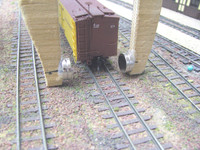I cut another fork that was narrower between the tines. I also placed the magnets lower. When I estimated things last night, I went with the coupler centerline in placing the magnets. However, what I want to attract, the metal “hose” area, is lower. So I lowered the magnets for they were flush with the bottom of the tines, also hoping to improve operation.
Equipped with single magnets on each side, ver 1.0 just wasn’t strong enough for reliable operation. So I doubled up the magnets. That worked pretty good, except the limited amount of steel in the cars was enough to cause problems letting go of the car! Hmmm, not good.
So there must be a happy medium. Returning to my slightly wider prototype fork, I also lowered the magnets so their lowest part matched the end of the fork. This solved the slight misalignment problem. Single magnets still didn’t have enough omph, so I went back to double magnets. After this mod, ver 1.1 did work better than it did in original configuration.
For the record, for HOn3 the inside tine width on the successful prototype/ver 1.1 is 1.75", with the magnets sitting inside of that of course. Two magnets stacked together is 7/32" for reference, leaving a gap of about 1 5/16". The less successful narrowed fork ver 1.0 had a tine width was 1.5", so you can see that this measurement is critical to achieving satisfactory performance; slight changes will cause big differences in whether it works well or not. Not all magnets are the same, so this optimal gap will vary.
Obviously, for different scales and, perhaps, even gauges you’ll have to determine optimal inside tine width for the magnets you use with them, too. I tried them on standard gauge cars and both are too narrow and thus have too strong a field to work right, tending to derail the cars. I will probably try a tine measurement in between the two to see how that works for HOn3 and a wider tine for standard gauge, so will post those when I do.
BTW, I haven’t tried these in actual operation so f


